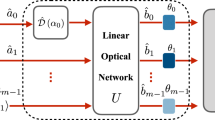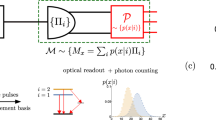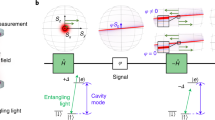Abstract
The precision of quantum metrology is widely believed to be restricted by the Heisenberg limit, corresponding to a root mean square error that is inversely proportional to the number of independent processes probed in an experiment, N. In the past, some proposals have challenged this belief, for example, using nonlinear interactions among the probes. However, these proposals turned out to still obey the Heisenberg limit with respect to other relevant resources, such as the total energy of the probes. Here we present a photonic implementation of a quantum metrology protocol surpassing the Heisenberg limit by probing two groups of independent processes in a superposition of two alternative causal orders. Each process creates a phase-space displacement, and our setup is able to estimate a geometric phase associated with two sets of N displacements with an error that falls quadratically with N. Our results only require a single-photon probe with an initial energy that is independent of N. Using a superposition of causal orders outperforms every setup where the displacements are probed in a definite order. Our experiment features the demonstration of indefinite causal order in a continuous-variable system, and opens up the experimental investigation of quantum metrology setups boosted by indefinite causal order.
This is a preview of subscription content, access via your institution
Access options
Access Nature and 54 other Nature Portfolio journals
Get Nature+, our best-value online-access subscription
$29.99 / 30 days
cancel any time
Subscribe to this journal
Receive 12 print issues and online access
$209.00 per year
only $17.42 per issue
Buy this article
- Purchase on Springer Link
- Instant access to full article PDF
Prices may be subject to local taxes which are calculated during checkout





Similar content being viewed by others
Data availability
The data that support the findings of this study are presented in the article and Supplementary Information, and are available from the corresponding authors upon reasonable request. Source data are provided with this paper.
References
Giovannetti, V., Lloyd, S. & Maccone, L. Quantum-enhanced measurements: beating the standard quantum limit. Science 306, 1330–1336 (2004).
Giovannetti, V., Lloyd, S. & Maccone, L. Quantum metrology. Phys. Rev. Lett. 96, 010401 (2006).
Giovannetti, V., Lloyd, S. & Maccone, L. Advances in quantum metrology. Nat. Photon. 5, 222–229 (2011).
Bollinger, J. J., Itano, W. M., Wineland, D. J. & Heinzen, D. J. Optimal frequency measurements with maximally correlated states. Phys. Rev. A 54, R4649 (1996).
Walther, P. et al. De Broglie wavelength of a non-local four-photon state. Nature 429, 158–161 (2004).
Afek, I., Ambar, O. & Silberberg, Y. High-NOON states by mixing quantum and classical light. Science 328, 879–881 (2010).
Chen, G. et al. Heisenberg-scaling measurement of the single-photon Kerr non-linearity using mixed states. Nat. Commun. 9, 93 (2018).
Chen, G. et al. Achieving Heisenberg-scaling precision with projective measurement on single photons. Phys. Rev. Lett. 121, 060506 (2018).
Anisimov, P. M. et al. Quantum metrology with two-mode squeezed vacuum: parity detection beats the Heisenberg limit. Phys. Rev. Lett. 104, 103602 (2010).
Beltrán, J. & Luis, A. Breaking the Heisenberg limit with inefficient detectors. Phys. Rev. A 72, 045801 (2005).
Boixo, S., Flammia, S. T., Caves, C. M. & Geremia, J. M. Generalized limits for single-parameter quantum estimation. Phys. Rev. Lett. 98, 090401 (2007).
Roy, S. & Braunstein, S. L. Exponentially enhanced quantum metrology. Phys. Rev. Lett. 100, 220501 (2008).
Choi, S. & Sundaram, B. Bose-Einstein condensate as a nonlinear Ramsey interferometer operating beyond the Heisenberg limit. Phys. Rev. A 77, 053613 (2008).
Zwierz, M., Pérez-Delgado, C. A. & Kok, P. General optimality of the Heisenberg limit for quantum metrology. Phys. Rev. Lett. 105, 180402 (2010).
Napolitano, M. et al. Interaction-based quantum metrology showing scaling beyond the Heisenberg limit. Nature 471, 486–489 (2011).
Yang, Y. Memory effects in quantum metrology. Phys. Rev. Lett. 123, 110501 (2019).
Zwierz, M., Pérez-Delgado, C. A. & Kok, P. Ultimate limits to quantum metrology and the meaning of the Heisenberg limit. Phys. Rev. A 85, 042112 (2012).
Berry, D. W., Hall, M. J., Zwierz, M. & Wiseman, H. M. Optimal Heisenberg-style bounds for the average performance of arbitrary phase estimates. Phys. Rev. A 86, 053813 (2012).
Hall, M. J. & Wiseman, H. M. Does nonlinear metrology offer improved resolution? Answers from quantum information theory. Phys. Rev. X 2, 041006 (2012).
Zhao, X., Yang, Y. & Chiribella, G. Quantum metrology with indefinite causal order. Phys. Rev. Lett. 124, 190503 (2020).
Chiribella, G., D’Ariano, G., Perinotti, P. & Valiron, B. Beyond quantum computers. Preprint at https://arxiv.org/abs/0912.0195v1 (2009).
Chiribella, G., D’Ariano, G. M., Perinotti, P. & Valiron, B. Quantum computations without definite causal structure. Phys. Rev. A 88, 022318 (2013).
Hardy, L. Towards quantum gravity: a framework for probabilistic theories with non-fixed causal structure. J. Phys. A 40, 3081 (2007).
Oreshkov, O., Costa, F. & Brukner, Č. Quantum correlations with no causal order. Nat. Commun. 3, 1092 (2012).
Chiribella, G. Perfect discrimination of no-signalling channels via quantum superposition of causal structures. Phys. Rev. A 86, 040301(R) (2012).
Araújo, M., Costa, F. & Brukner, Č. Computational advantage from quantum-controlled ordering of gates. Phys. Rev. Lett. 113, 250402 (2014).
Guérin, P. A., Feix, A., Araújo, M. & Brukner, Č. Exponential communication complexity advantage from quantum superposition of the direction of communication. Phys. Rev. Lett. 117, 100502 (2016).
Ebler, D., Salek, S. & Chiribella, G. Enhanced communication with the assistance of indefinite causal order. Phys. Rev. Lett. 120, 120502 (2018).
Felce, D. & Vedral, V. Quantum refrigeration with indefinite causal order. Phys. Rev. Lett. 125, 070603 (2020).
Frey, M. Indefinite causal order aids quantum depolarizing channel identification. Quantum Inf. Process. 18, 96 (2019).
Mukhopadhyay, C., Gupta, M. K. & Pati, A. K. Superposition of causal order as a metrological resource for quantum thermometry. Preprint at https://arxiv.org/abs/1812.07508 (2018).
Chapeau-Blondeau, F. Noisy quantum metrology with the assistance of indefinite causal order. Phys. Rev. A 103, 032615 (2021).
Procopio, L. M. et al. Experimental superposition of orders of quantum gates. Nat. Commun. 6, 7913 (2015).
Rubino, G. et al. Experimental verification of an indefinite causal order. Sci. Adv. 3, e1602589 (2017).
Goswami, K. et al. Indefinite causal order in a quantum switch. Phys. Rev. Lett. 121, 090503 (2018).
Wei, K. et al. Experimental quantum switching for exponentially superior quantum communication complexity. Phys. Rev. Lett. 122, 120504 (2019).
Goswami, K., Cao, Y., Paz-Silva, G., Romero, J. & White, A. Increasing communication capacity via superposition of order. Phys. Rev. Research 2, 033292 (2020).
Taddei, M. M. et al. Computational advantage from the quantum superposition of multiple temporal orders of photonic gates. PRX Quantum 2, 010320 (2021).
Guo, Y. et al. Experimental transmission of quantum information using a superposition of causal orders. Phys. Rev. Lett. 124, 030502 (2020).
Aharonov, Y. & Bohm, D. Significance of electromagnetic potentials in the quantum theory. Phys. Rev. 115, 485 (1959).
Berry, M. V. Quantal phase factors accompanying adiabatic changes. Proc. R. Soc. Lond. A 392, 45–57 (1984).
Garay, L. J. Quantum gravity and minimum length. Int. J. Mod. Phys. A 10, 145–165 (1995).
Szabo, R. J. Quantum field theory on noncommutative spaces. Phys. Rep. 378, 207–299 (2003).
Pikovski, I., Vanner, M. R., Aspelmeyer, M., Kim, M. & Brukner, Č. Probing Planck-scale physics with quantum optics. Nat. Phys. 8, 393–397 (2012).
Kempf, A., Mangano, G. & Mann, R. B. Hilbert space representation of the minimal length uncertainty relation. Phys. Rev. D 52, 1108 (1995).
Aguilar, G., Piera, R., Saldanha, P., de Matos Filho, R. & Walborn, S. Robust interferometric sensing using two-photon interference. Phys. Rev. Applied 14, 024028 (2020).
Demkowicz-Dobrzański, R., Kolodyński, J. & Guţă, M. The elusive Heisenberg limit in quantum enhanced metrology. Nat. Commun. 3, 1063 (2012).
Acknowledgements
This work was supported by the Innovation Program for Quantum Science and Technology (no. 2021ZD0301200), National Natural Science Foundation of China (grant nos. 12122410, 92065107, 11874344, 61835004, 11821404), Anhui Initiative in Quantum Information Technologies (AHY060300), the Fundamental Research Funds for the Central Universities (grant nos. WK2030000038, WK2470000034), the Hong Kong Research Grant Council through grant 17300918 and through the Senior Research Fellowship Scheme SRFS2021-7S02, the Croucher Foundation, and the ID No. 62312 Grant from the John Templeton Foundation, as part of The Quantum Information Structure of Spacetime Project (QISS, https://www.qiss.fr/). Research at the Perimeter Institute is supported by the Government of Canada through the Department of Innovation, Science and Economic Development, Canada, and by the Province of Ontario through the Ministry of Research, Innovation and Science. The opinions expressed in this publication are those of the authors and do not necessarily reflect the views of the John Templeton Foundation.
Author information
Authors and Affiliations
Contributions
P.Y., X.Z., Y.Y. and G. Chiribella proposed the framework of the theory and made the calculations. P.Y., W.-H.Z., G.-C.L. and G. Chen planned and designed the experiment. P.Y. and G. Chen carried out the experiment assisted by B.-H.L., J.-S.X., Y.-J.H. and Y.G. P.Y., G. Chen, X.Z., Y.Y. and G. Chiribella analysed the experimental results and wrote the manuscript. G.-C.G., C.-F.L. and G. Chiribella supervised the project. All the authors discussed the experimental procedures and results.
Corresponding authors
Ethics declarations
Competing interests
The authors declare no competing interests.
Peer review
Peer review information
Nature Physics thanks Jonatan Brask and the other, anonymous, reviewer(s) for their contribution to the peer review of this work.
Additional information
Publisher’s note Springer Nature remains neutral with regard to jurisdictional claims in published maps and institutional affiliations.
Supplementary information
Supplementary Information
Supplementary Notes 1 and 2 and Fig. 1.
Rights and permissions
Springer Nature or its licensor (e.g. a society or other partner) holds exclusive rights to this article under a publishing agreement with the author(s) or other rightsholder(s); author self-archiving of the accepted manuscript version of this article is solely governed by the terms of such publishing agreement and applicable law.
About this article
Cite this article
Yin, P., Zhao, X., Yang, Y. et al. Experimental super-Heisenberg quantum metrology with indefinite gate order. Nat. Phys. 19, 1122–1127 (2023). https://doi.org/10.1038/s41567-023-02046-y
Received:
Accepted:
Published:
Issue Date:
DOI: https://doi.org/10.1038/s41567-023-02046-y



